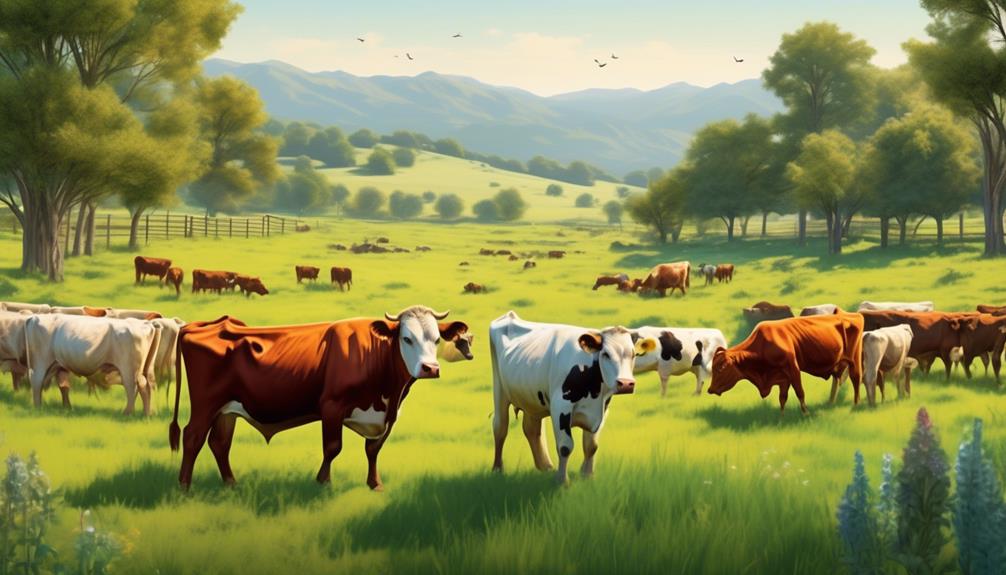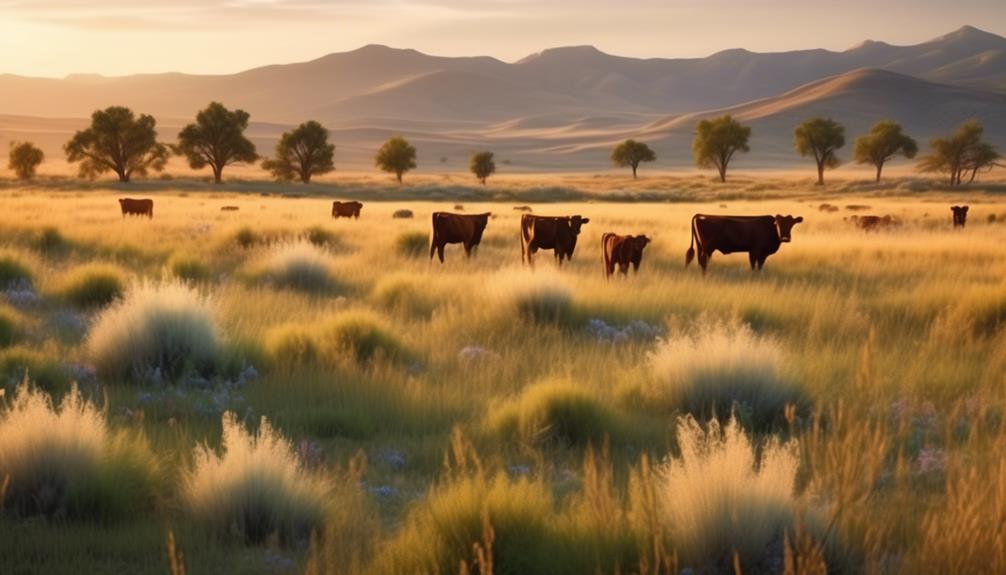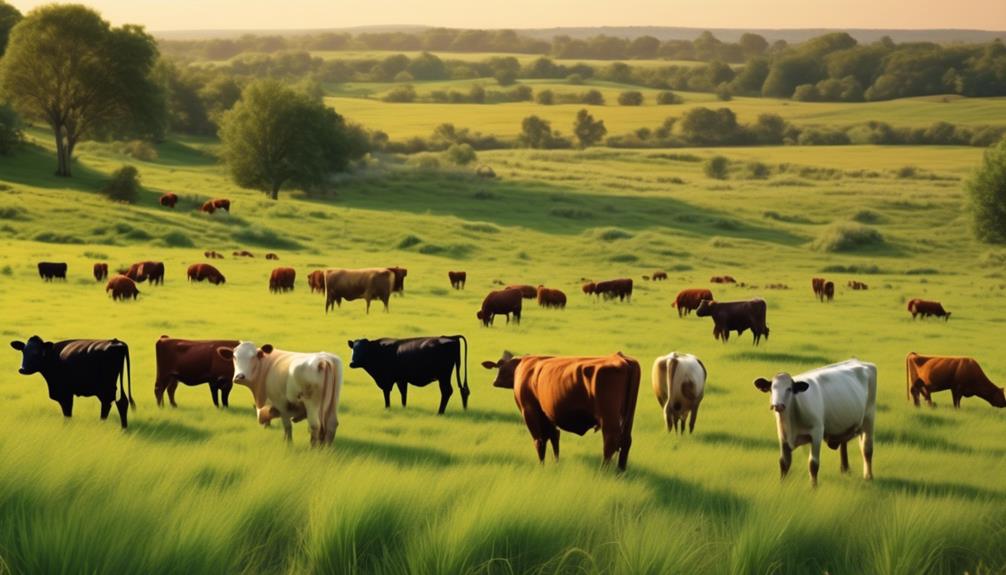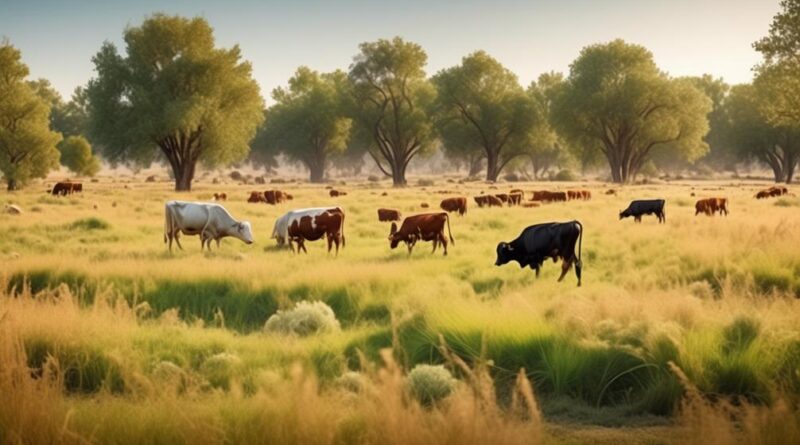What Sustainable Practices Promote Biodiversity in Cattle Management?
You may not realize that cattle management practices can significantly impact biodiversity. However, by implementing sustainable practices, you can promote a healthier and more diverse ecosystem within your cattle operation.
From rotational grazing to agroforestry integration, there are numerous methods that not only benefit the environment but also contribute to the overall well-being of your cattle. These sustainable practices not only support biodiversity but also offer a range of additional benefits that you may find surprising.
Rotational Grazing

To maximize pasture productivity and encourage even foraging, implement rotational grazing on your cattle farm. Grazing patterns play a crucial role in maintaining ecological balance and promoting sustainable practices. By rotating your cattle through different grazing areas, you can ensure that the vegetation has time to recover, leading to healthier pastures and improved biodiversity. This method also helps in preventing overgrazing in specific areas, allowing the vegetation to regenerate and support a variety of wildlife.
When you implement rotational grazing, you're actively contributing to the ecological balance of your farm. By managing the movement of your cattle, you prevent the degradation of pastures and minimize soil erosion, which can have a significant impact on the overall health of the ecosystem. Furthermore, rotational grazing can lead to more efficient nutrient distribution as the cattle's waste is spread across different areas, enriching the soil and promoting healthy plant growth.
Agroforestry Integration
Implementing agroforestry integration enhances the sustainability of cattle management by incorporating trees and shrubs into pasture areas, providing various environmental and economic benefits.
Tree planting within pasture spaces not only offers shade and shelter for livestock but also contributes to the overall ecological balance. Silvopasture, the integration of trees and livestock, promotes biodiversity by creating diverse habitats that support a variety of species, from insects to birds.
The strategic placement of trees within grazing areas helps to mitigate the impact of heat stress on cattle, fostering animal welfare and improving productivity. Additionally, the presence of trees aids in reducing soil erosion and improving water retention, thereby contributing to overall soil health. This approach not only benefits the cattle but also promotes the conservation of natural resources.
Furthermore, agroforestry integration offers economic advantages by diversifying farm products. Trees and shrubs can provide additional sources of income through timber, fruits, nuts, and medicinal plants, thereby enhancing the overall sustainability of the agricultural enterprise. Livestock integration with trees also presents opportunities for carbon sequestration, contributing to climate change mitigation efforts.
Incorporating agroforestry into cattle management practices is a holistic approach that not only benefits the environment and biodiversity but also offers economic incentives, making it a valuable practice for sustainable and diversified agricultural systems.
Native Grassland Restoration

Restoring native grasslands is a crucial aspect of sustainable cattle management, as it supports biodiversity and enhances the ecological balance of pasture areas. When implementing native grassland restoration, consider the following:
- Grazing Management: Introduce rotational grazing to prevent overgrazing and allow grasslands to recover. By rotating cattle through different grazing areas, the grasslands have the opportunity to regenerate, fostering diverse plant species crucial for a healthy ecosystem.
- Ecosystem Restoration: Utilize native grass species in restoration efforts to rebuild the natural habitat. Native grasses are adapted to the local climate and soil conditions, providing essential food and shelter for wildlife, insects, and soil microorganisms.
- Soil Health: Focus on improving soil health through sustainable practices such as minimal tillage and the use of cover crops. Healthy soil supports the growth of diverse grass species, which in turn enriches the ecosystem and provides better forage for cattle.
- Invasive Species Management: Implement proactive measures to control and eradicate invasive plant species. Invasive plants can outcompete native grasses, reducing biodiversity and disrupting the delicate balance of the grassland ecosystem.
Water Resource Management
When managing water resources for sustainable cattle practices, it's essential to prioritize efficient usage and conservation to complement the restoration of native grasslands. Wetland conservation plays a crucial role in maintaining the overall health of ecosystems. By preserving wetlands, you not only ensure a sustainable water supply for cattle but also contribute to the preservation of diverse plant and animal species.
Additionally, improving irrigation efficiency is vital for sustainable water resource management. Implementing modern irrigation techniques and technologies can significantly reduce water wastage and optimize water usage, thereby supporting both cattle management and overall ecosystem health.
Riparian restoration is another key aspect of water resource management in cattle practices. Protecting and restoring riparian zones along water bodies not only helps in maintaining water quality but also aids in the preservation of biodiversity. By preventing soil erosion and filtering out pollutants, healthy riparian areas contribute to the overall well-being of aquatic ecosystems and the sustainability of water resources for cattle.
Soil Health Improvement

To enhance the health of the soil in your cattle management practices, consider incorporating sustainable grazing techniques to promote natural fertilization and minimize soil compaction. By implementing these techniques, you can significantly improve the soil health on your farm and create a more sustainable environment for your cattle.
Here are four effective methods to improve soil health in your cattle management practices:
- Compost Application: Utilize compost made from cattle manure and organic matter to enhance soil fertility and structure. This will also help in replenishing essential nutrients in the soil, creating a healthier environment for plant growth.
- Cover Cropping: Integrate cover crops such as legumes and grasses into your grazing rotation to minimize soil erosion and increase organic matter content. These cover crops can also help in fixing nitrogen in the soil, reducing the need for synthetic fertilizers.
- Rotational Grazing: Implement a rotational grazing system to allow for periods of rest for pastures. This practice prevents overgrazing, promotes natural fertilization through the distribution of manure, and enhances soil microbial activity.
- Minimize Soil Compaction: Utilize proper grazing management to minimize soil compaction caused by heavy trampling. This can be achieved by adjusting stocking rates and using strategic grazing patterns to prevent excessive pressure on the soil.
Incorporating these sustainable practices into your cattle management can lead to improved soil health, resulting in better pasture productivity and overall environmental sustainability.
Integrated Pest Management
Incorporating sustainable pest management practices into your cattle management can significantly reduce reliance on chemical pesticides, aligning with your goal of promoting a healthier and more balanced ecosystem on your farm.
Integrated Pest Management (IPM) focuses on minimizing the use of synthetic chemicals by integrating biological control methods and habitat enhancement. Biological control involves using natural predators, parasites, and pathogens to manage pest populations. For example, introducing beneficial insects like ladybugs or parasitic wasps can help control pest insects such as flies or ticks that affect your cattle. By encouraging the presence of these natural enemies, you can effectively reduce the need for chemical insecticides.
Habitat enhancement is another key aspect of IPM. By creating diverse and healthy habitats on your farm, you can promote natural pest control. Planting diverse vegetation, maintaining proper water sources, and creating suitable nesting sites for beneficial organisms such as birds and bats can contribute to controlling pest populations. For instance, attracting insectivorous birds to your farm can help in controlling insect pests.
Additionally, implementing cultural control practices such as rotational grazing and proper waste management can further support sustainable pest management.
Biodiversity Monitoring
Consider implementing regular biodiversity monitoring practices to assess the health and diversity of the ecosystems on your farm. By doing so, you can gain valuable insights into the state of your environment and make informed decisions to support biodiversity and ecosystem resilience.
Here are some essential components of biodiversity monitoring:
- Species Diversity Surveys: Conduct regular surveys to monitor the variety and abundance of plant and animal species on your farm. This will help you understand the changes in species composition and identify any potential threats to biodiversity.
- Habitat Assessment: Evaluate different habitats on your farm, such as grasslands, wetlands, and forests, to assess their suitability for supporting diverse flora and fauna. Understanding the quality of habitats is crucial for maintaining a balanced ecosystem.
- Population Trend Analysis: Track the population trends of key species to gauge the overall health of the ecosystem. Monitoring the fluctuations in population sizes can provide early indications of environmental changes that may impact biodiversity.
- Community Engagement: Involve the local community, including experts and volunteers, in biodiversity monitoring efforts. Collaborative monitoring not only increases the amount of data collected but also raises awareness about the importance of biodiversity conservation.
Regular biodiversity monitoring not only helps in understanding the current state of species diversity but also contributes to building ecosystem resilience. It enables you to make informed decisions to protect and enhance the biodiversity on your farm, ensuring a healthy and sustainable environment for both your cattle and the surrounding wildlife.
Sustainable Feed Management
Assessing how biodiversity monitoring data can inform sustainable feed management practices is crucial for promoting the health of both cattle and the surrounding ecosystem. One key aspect to consider is feed efficiency, which can be achieved by optimizing feed types and formulations tailored to the specific nutritional needs of cattle. This ensures that cattle receive necessary nutrients while minimizing waste.
Another crucial element is nutrient recycling, which plays a significant role in sustainable feed management. Implementing practices like composting manure to create organic fertilizers helps close the nutrient loop within the farm ecosystem. This reduces waste's environmental impact and minimizes nutrient runoff into waterways and soil degradation, benefiting the health of the surrounding ecosystem.
Incorporating diverse forage options into the cattle's diet is also essential. Diverse forage not only provides a range of nutrients for cattle but also supports biodiversity by creating varied habitats for flora and fauna. This approach contributes to the overall health and resilience of the ecosystem, benefiting both cattle and the environment.
Frequently Asked Questions
How Does Cattle Management Impact the Genetic Diversity of Native Grassland Species?
When you manage cattle, their grazing habits impact genetic diversity of native grassland species. This leads to habitat fragmentation, genetic drift, and reduced species resilience. Consider sustainable practices to minimize these effects and promote biodiversity.
What Are the Economic Benefits of Implementing Agroforestry in Cattle Management Practices?
To promote biodiversity in cattle management, incorporating agroforestry practices can bring economic benefits. By improving soil fertility and enhancing carbon sequestration, agroforestry not only supports biodiversity but also provides additional income opportunities for farmers.
How Does Water Resource Management in Cattle Management Contribute to the Conservation of Aquatic Biodiversity?
In cattle management, water resource management is crucial for conserving aquatic biodiversity. By preventing soil erosion from runoff, you can protect aquatic ecosystems. Implementing sustainable practices like riparian buffers and rotational grazing can help maintain water quality and biodiversity.
What Specific Soil Health Improvements Have Been Shown to Most Effectively Support Biodiversity in Cattle Management?
To promote biodiversity in cattle management, focus on soil fertility and conservation grazing. These practices have been shown to effectively support biodiversity. By implementing them, you can make a positive impact on the environment.
How Can Integrated Pest Management in Cattle Management Practices Help to Preserve Local Insect and Bird Species Diversity?
Integrated pest management in cattle management practices helps preserve local insect and bird species diversity by promoting ecological balance. Implementing sustainable practices, such as rotational grazing and natural habitat preservation, can contribute to maintaining local species populations.
Conclusion
By implementing sustainable practices such as:
- Rotational grazing
- Agroforestry integration
- Native grassland restoration
- Water resource management
- Soil health improvement
- Integrated pest management
- Biodiversity monitoring
- Sustainable feed management
You can promote biodiversity in cattle management.
These practices not only benefit the environment but also contribute to the overall health and well-being of your cattle, creating a more sustainable and resilient farming system.
